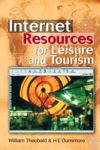
Professor and Chairman Emeritus, Recreation and Tourism Programme, Purdue University, West Lafayette, Indiana, USA
H.E. Dunsmore
Department of Computer Science, Purdue University, West Lafayette, Indiana, USA

|
William Theobald Professor and Chairman Emeritus, Recreation and Tourism Programme, Purdue University, West Lafayette, Indiana, USA H.E. Dunsmore Department of Computer Science, Purdue University, West Lafayette, Indiana, USA |
Page 76: The paragraph numbered 3 should be replaced by the following:
3 Reload -- reload the current Web page from its server. This process is actually a little more sophisticated and efficient than it sounds. Let us suppose that you are looking at Travel Stop's upcoming cruises Website at http://www.travel-stop.co.uk/cruise_c.htm. If you want to make sure that you are looking at absolutely the latest cruise information (assuming that a new cruise might have been added to their repertoire in the last thirty minutes), click on the Reload button. What happens then is that your Web browser sends a request to the server at www.travel-stop.co.uk for the cruise_c.htm page. But, along with the request, it lets the server know that the copy of this page you have is dated 5:07 pm, June 25, 2001. If the server has a newer copy of this page, it sends it to your browser in response to the "Reload". Otherwise, your browser is notified that you have the most recent copy and valuable Internet resources are not taken up by sending you a copy of a Web page that you already have. By the way, this button is called "Refresh" by the Microsoft Internet Explorer.
Page 82: The first three paragraphs of the Bookmarks section should be replaced by the following:
Often times when visiting a Website you may say to yourself (quietly if there are other people around), "This is a really interesting Website. I would like to be able to return to it again easily later." What are your alternatives? If you got there via a hyperlink from some other Website, you can always re-trace that route again later. But, that may not be very easy. If you have written down the URL, you may always re-type it to the File pull-down menu Open Page entry or to the Location field of your browser. But, re-typing a URL like http://www.travel-stop.co.uk/cruise_c.htm is both time-consuming and error prone.
The best solution is to add such a Web page to your Bookmarks. Every Web browser has a file of Websites selected by the user of the browser for fast-and-easy return later. When you are visiting http://www.travel-stop.co.uk/cruise_c.htm, simply click on the Bookmarks icon on the Location Toolbar and select "Add Bookmark". Later, any time you click on the Bookmarks icon on the Location Toolbar, the Travel Stop Cruise Web page will be among those listed. Simply click on that entry and off you go to http://www.travel-stop.co.uk/cruise_c.htm.
What we did above is really not the best way to establish a bookmark. It is usually best to add the home page of a Website to your Bookmarks rather than just some page you find at the Website. So, it is probably better to go to http://www.travel-stop.co.uk, the homepage of Travel Stop's Website and put that in your Bookmarks. From that page there are immediate links to Online Booking, Latest Cruise Offers, Late Bookings, Personal Itineraries, and Personal Service. So, you can still get to http://www.travel-stop.co.uk/cruise_c.htm easily -- just one click from Travel Stop's homepage. Another reason why bookmarking the homepage of a Website instead of a sub-page is a good idea is that Websites are frequently re-organized with Web pages being moved and even re-named. A bookmark to a subpage like cruise_c.htm may not work after a while, but it is highly unlikely that a bookmark to http://www.travel-stop.co.uk will become defunct any time soon.
Some Interesting Links
Cookies: What They Are, Why You Are In Charge